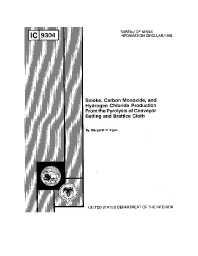Mining Publication: Smoke, Carbon Monoxide, and Hydrogen Chloride Production from the Pyrolysis of Conveyor Belting and Brattice Cloth
Original creation date: January 1992
In an underground mine fire, a toxic mixture of combustion product gases and particulate matter is transported by the ventilating system, endangering everyone downstream. To determine the magnitude of the problem that these toxic combustion products pose, the U.S. Bureau of Mines is investigating the combustion products of typical materials found in underground mines. The total toxicity of the combustion products depends upon the evolving gas species and particulate matter, the amount of material involved, and the ventilation rate. In a simulated mine environment, the products from smoldering polyvinyl chloride (PVC) brattice and conveyor belting were analyzed for gas concentrations and smoke characteristics. The primary toxic gases are hydrogen chloride and carbon monoxide. Smoldering conveyor belts are more detectable than smoldering pvc brattice cloths. These results, combined with previous analyses, are used to estimate relative toxicities, product levels, and detectability of smoldering mine combustibles.
Authors: MR Egan
Information Circular - January 1992
NIOSHTIC2 Number: 10011119
U.S. Department of the Interior, Bureau of Mines, Information Circular 9304, 1992 Jan:1-14
See Also
- A 20-Liter Furnace Test Method to Determine the Combustion Gas Toxicity of Conveyor Belts
- Analysis of Underground Coal Mine Fire Incidents in the United States from 1978 through 1992
- CFD Analysis of Mine Fire Smoke Spread and Reverse Flow Conditions
- CFD Modeling of Fire Spread Along Combustibles in a Mine Entry
- Experimental and Modeling Investigation of the Effect of Ventilation on Smoke Rollback in a Mine Entry
- Fire Response Preparedness for Underground Mines
- Initial Study of Buried Communication Cable for Underground Mines
- Remote Mine Fire Suppression Technology
- The Status of Mine Fire Research in the United States
- Understanding Mine Fire Disasters by Determining the Characteristics of Deep-Seated Fires
- Content source: National Institute for Occupational Safety and Health, Mining Program


 ShareCompartir
ShareCompartir
